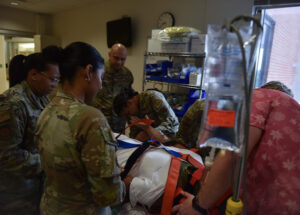
Story by Jasmine Braswell
Air Combat Command
JOINT BASE LANGLEY-EUSTIS, Va. – The U.S. Air Force Medical Service has implemented a strategic initiative designed to train all medical Airmen to provide foundational clinical support to wounded and injured personnel on the battlefield, MEDIC-X.
With MEDIC-X, every Air Force medic, including those not involved in patient care like administrators or lab technicians, need to be proficient in 52 skills that ensure the Air Force’s medical force is ready for the next fight.
These 52 skills are not normally within a majority of medical group training, an administrator doesn’t typically do hands-on patient care. MEDIC-X trains them on skills needed in a deployed environment where the priority is not completing administrative tasks but saving lives. When deployed and resources are limited, they need to know how to perform some level of patient care.
Air Combat Command began MEDIC-X training July 1, 2023, divided into four quarters over a year, with 13 essential skills taught during each quarter.
“The goal of MEDIC-X is to enhance,” said Col. Tracey Sapp, Chief, Clinical Operations, Air Combat Command Surgeon General’s Office. “The medical providers and nursing services is a small asset with very limited numbers, so the program extends our hand in the ability to provide safe care to wounded and ill people and improve patient outcomes in contested environments.”
Airmen learn skills like assessment of pain levels, principles of infection control, and use of personal protective equipment.
“Classes include intravenous fluid management, pump management and measuring intake and output of fluids,” said Sapp. “The medics also learn to assist and perform spinal immobilization, dressing changes, on and off-loading of fixed wing aircraft, oxygen therapy, and checking vital signs like blood pressure, heart rate, and respirations.”
When the training is completed, the MEDIC-X toolbox will serve as a repository within the AFMS knowledge exchange, accessible to trainees. This includes videos, hands-on training and a complete final skills assessment.
A unique part of MEDIC-X is the simulation capability of virtual reality goggles and manikins. VR goggles provide an immersive computer-generated scenario, and high-fidelity manikins achieve the hands-on tactile experience. They enhance the program by producing realistic scenarios to demonstrate and verify skills.
“It’s exciting to me because as a nurse I love being able to see that we can utilize everybody to their highest level and ability in order to increase survivability in different conflicts,” Sapp said. “We wear this uniform for a reason and our medical forces are here to render aid and save lives in any contested environment.”
Medical groups will continue to focus on this training to fulfill readiness requirements to meet the needs of future scenarios.
“Now that the first year of training is complete, MTFs continue the cycle to train new personnel while reinforcing the skills for those who were trained in the first year,” she said. “Skills are also incorporated throughout the year into various exercises and training opportunities.”